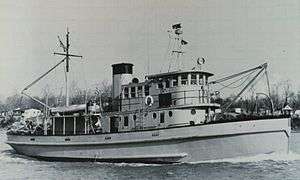USC&GS Marmer
USC&GS Marmer was a United States Coast and Geodetic Survey survey ship in commission from 1957 to 1968.
 USC&GS Marmer undergoing sea trials at Curtis Bay, Baltimore, Maryland, in the autumn of 1957 after her conversion to a survey ship. | |
| History | |
|---|---|
| Name: | USPHS Walter Wyman |
| Namesake: | Walter Wyman (1848–1911), Surgeon General of the United States (1891–1911) |
| Builder: | Spedden Shipbuilding, Baltimore, Maryland |
| Commissioned: | 1932 |
| Decommissioned: | 1957 |
| Fate: | Transferred to U.S. Coast and Geodetic Survey 24 May 1957 |
| History | |
| Name: | USC&GS Marmer |
| Namesake: | Harry A. Marmer (1885–1953), U.S. Coast and Geodetic Survey mathematician and oceanographer noted for his study of tides and currents |
| Acquired: | 24 May 1957 |
| Commissioned: | 1957 |
| Decommissioned: | 1968 |
| General characteristics | |
| Type: | Survey ship |
| Tonnage: | 196 gross tons[1] |
| Length: | 100.7 ft (30.7 m) |
| Beam: | 22 ft (6.7 m) |
| Draft: | 10 ft (3.0 m) |
Prior to her Coast and Geodetic Survey career, she served as the United States Public Health Service boarding tug USPHS Walter Wyman from 1932 to 1957.
Construction and Public Health Service career
Spedden Shipbuilding constructed the ship for the U.S. Public Health Service at Baltimore, Maryland, in 1932 as the boarding tug USPHS Walter Wyman. From 1932 to 1957, Walter Wyman carried Public Health Service personnel tasked with conducting shipboard health inspections to and from ships arriving in the United States. The Public Health Service retired Walter Wyman from service in 1957 and transferred her to the U.S. Coast and Geodetic Survey on 24 May 1957.[1][2]
Coast and Geodetic Survey career
On 27 May 1957, the Coast and Geodetic Survey renamed the vessel USC&GS Marmer. She underwent conversion to a survey ship, followed by sea trials at Curtis Bay in Baltimore in the autumn of 1957. After her successful completion of sea trials, the Coast and Geodetic Survey commissioned her later in 1957. Used for the study of currents, Marmer operated along the United States East Coast until 1968, when she was decommissioned and replaced by the auxiliary survey vessel USC&GS Ferrel (ASV 92).[1][2][3]
References
- "Spedden Shipbuilding, Baltimore MD". shipbuildinghistory.com. Retrieved 2016-03-13.
- "NOAA History: Coast and Geodetic Survey Ships: Marmer". Archived from the original on 2004-09-01. Retrieved 2016-03-13.
- "NOAA Photo Library: The Coast and Geodetic Survey Ship MARMER undergoing sea trials at Curtis Bay, Maryland, 1957 Fall". photolib.noaa.gov. Retrieved 2016-03-13.